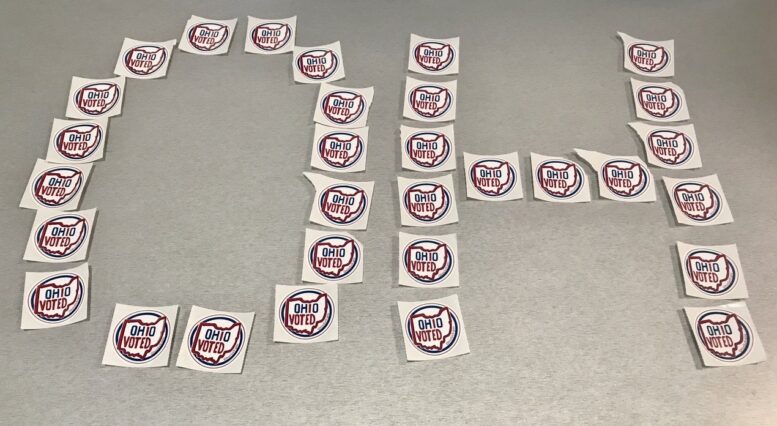From BGSU DEPARTMENT OF POLITICAL SCIENCE
The Democracy and Public Policy Research Network in the Department of Political Science at Bowling Green State University has released the results of its web-based poll of 1,000 likely Ohio voters conducted from Sept. 18 to Sept. 27.
[RELATED: BGSU students will get hands-on polling experience]
Topics covered in the September poll include:
- Presidential race
- Ohio U.S. Senate race
- Ohio Issue 1
- Ohioans’ thoughts on the current political environment
The nonpartisan poll of sampled Ohioans has a margin of error of +/- 3.6 percentage points.
A five-person research team in the BGSU Department of Political Science developed, ordered, tested and analyzed the questions in the poll.
A second poll of likely Ohio voters is set for distribution in October with a release date forthcoming.
For the poll, YouGov, a well-known international online research data and analytics technology group, gathered public opinion data through questions sent in online surveys, emails and text messages.
For more information, visit BGSU.edu/DePo.
Analysis of the poll
By ROBERT ALEXANDER, BGSU
The Democracy and Public Policy Research Network at Bowling Green State University has released its September poll, a web-based poll of 1,000 likely Ohio voters conducted from Sept. 18 to Sept. 27, 2024. The poll has a margin of error of +/- 3.6 percentage points and was conducted under the direction of Bowling Green State University professors Dr. Robert Alexander, Dr. Melissa Miller, Dr. David Jackson, Dr. Nicole Kalaf-Hughes, and Dr. Joshua Boston in partnership with YouGov.
Trump continues to show strength in Ohio
Donald Trump continues to poll strongly in Ohio besting Kamala Harris 51-44 among likely voters. Trump has won the Buckeye state in his two previous campaigns by nearly identical 8-point margins. Fifty-nine percent of respondents believe the country’s economic condition has worsened in the last year and only twenty-three percent believe the country is headed in the right direction.
Trump continues to be a polarizing figure as a nearly equal number of respondents hold favorable (46%) versus unfavorable (49%) views of him. Yet, Harris has a higher unfavorable rating than most public figures we polled with an overall rating of -10 (43% favorable, 53% unfavorable).
Robert Alexander, Bowling Green State University: “Donald Trump continues to hold a solid lead in Ohio. While nearly half of the electorate holds an unfavorable view of him, many Ohioans continue to be disappointed in the current economic climate.”
Sherrod Brown and Bernie Moreno locked in tight race
Ohio’s U.S. Senate race is being closely watched across the country and promises to be incumbent Sherrod Brown’s toughest contest. We find Brown with a slight edge, 49% to 45% against his opponent, Republican Bernie Moreno. Brown is seeking his 4th term as a U.S Senator and has won each of his previous campaigns by at least 6 points. Brown is the only public figure who holds a net positive favorability rating among respondents (+1), while Moreno has the lowest net favorability rating at -14. Nearly 1 in 5 of those polled report having neither a favorable nor unfavorable view of Moreno, suggesting there is room for both growth or slippagein his campaign.
Robert Alexander, Bowling Green State University: “This will likely be Sherrod Brown’s most difficult Senate campaign. His success or failure will say a lot about the future competitiveness between Democrats and Republicans in Ohio for the foreseeable future.” – Issue 1 – solid backing with limited awareness
Respondents registered solid support for Issue 1
Issue 1 would establish an Ohio Citizens Redistricting Commission to redraw state legislative and congressional districts every ten years.
Sixty percent plan to vote “yes” in favor of Issue 1, while 20 percent plan to vote “no” and 20 percent are not sure.
Melissa Miller, Bowling Green State University: “In both 2015 and 2018 Ohio voters overwhelmingly approved measures designed to reduce partisan gerrymandering. Our results suggest we’re headed for a similar result in 2024.”
Partisan differences over Issue 1 are clear in the results. Eighty-two percent of Democrats back the measure versus only 41 percent of Republicans. Among independents, 57 percent plan to vote in favor of Issue 1.
Awareness of the ballot measure was somewhat limited. Fifty-one percent of respondents said they had heard a little about Issue 1, while 22 percent reported hearing a lot. Twenty-eight percent reported hearing nothing at all.
Melissa Miller, Bowling Green State University: “Voters tend to pay the most attention to the top of the ticket during presidential election years. In this respect, it’s not surprising that nearly 3 in 10 Ohio voters have not heard anything about Issue 1.”
A toxic political environment fueled by partisan polarization
Ohioans believe that the current political environment is as toxic as it has ever been in their lifetimes (84%), but also believe overwhelmingly that it is important for people with differences of opinion to talk to one another (85%).
When thinking about politics, most of our respondents feel exhausted (86%) and angry (85%) at least some of the time. In addition, large majorities believe that the current political environment will lead to increased violence (79%), that the current political environment has weakened the U.S. on the world stage (82%), and that there are serious threats to the future of democracy given the issues that currently divide the country (83%).
We find a very deep divide in the ways that Democrats and Republicans view one another. Large majorities of Democrats believe that Republicans are close minded (88%), dishonest (84%), and immoral (75%). Very few Democrats believe that Republicans are honest (8%) or tolerant (4%).
A similar story emerges when looking at how Republicans view Democrats.
Seventy-nine percent believe that Democrats are dishonest, 74% believe they are immoral, and 59% believe they are lazy. Just 8% of Republicans believe that Democrats are honest and 12% believe that Democrats are tolerant.
Robert Alexander, Bowling Green State University: “The differences in how Democrats and Republicans currently view one another is sobering. Calls for civil discourse are difficult when so many see ‘the other side’ as immoral and dishonest.”

